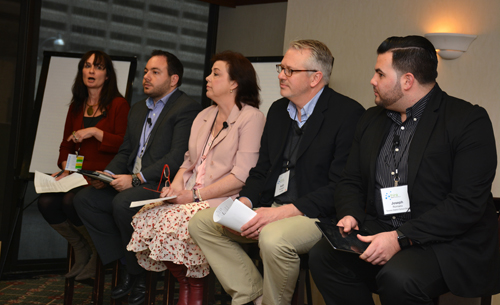We know that our educations systems must change to prepare students for a future we can’t fathom. With discussion from emerging leaders using technology to enable self-directed, collaborative, participatory learning in our own backyard, here are the key takeaways.
Workshop Moderator: Fiona Deller
Speakers: Keith Hampson, Joseph Romano, Anita Simpson, Brandon Zoras
Empower Teachers to Fail Well.
The workshop discussion emphasized teaching as a learning process – and learning from our mistakes – and being confident enough to sometimes fail, as we try to innovate in the classroom. The breaking and remaking of learning may have just as much to do with the educators as the students, and educators can expand their horizons if they rethink the way they teach. Just as educators give students permission to practice, fail and try again, could the lesson of break and remaking learning also be to break and remake teaching?
How to Cause Disruption.
Panellists discussed how teachers often cement teaching methodologies and eye change with wariness. As an educator, do you find yourself relying on tried-and-true curriculum because it “guarantees” desired outcomes among students? It’s time to reconsider the creation of content…
Co-create Curriculum.
Anita Simpson suggested that curriculum needs to be made in partnership with the learners. She leaves us with a challenging question: Who are we, as policy makers, to tell students exactly what and how they should learn? Involving the recipients of curriculum might just lead to breakthroughs in learning objectives. Keith Hampson added that institutions can benefit from a shift in instructional design. Let students ask questions, encourage peer-to-peer learning, and be open to what ideas and challenges students bring forth. Get out of the students’ way—they’ll find a way to use technology; just encourage them to use it. Would we want to help raise a generation of students who create, rather than consume content? Case in point: in England, coding is introduced into grade-one curriculum.
Break, Remake, and Repeat.
Brandon Zoras and Joseph Romano, pointing out an iPad, asks, so what can we do with devices? Imagine the possibilities of technology in the classroom if educators are constantly evaluating and revising pedagogy. Just as quickly as technology changes, educators should be in-step with the kind of innovations they can implement in their teaching, in order to enhance students’ learning experiences.
Plus, view the images below for ideas and solutions brought up in the brainstorming session.
For more THINK 2015 stories, you might like
- Part 2 THINK 2015 Workshop Notes: MUSH to Mashup
- Part 3 THINK 2015 Workshop Notes: Bringing Research to the Crowd
- In honour of THINK, WebPal is offering any connected ORION institution a research data management account, worth 10 terabytes, for free.







